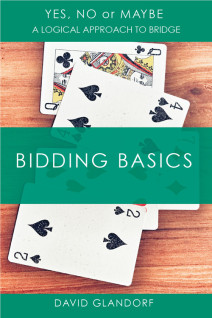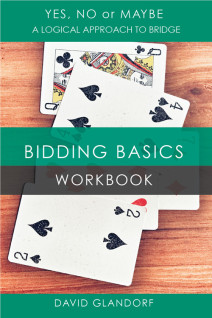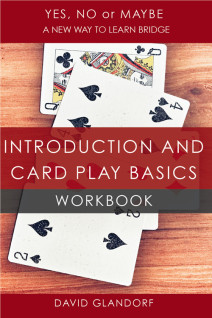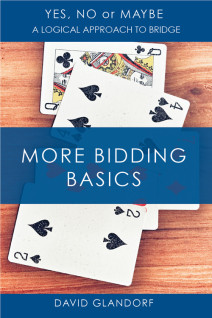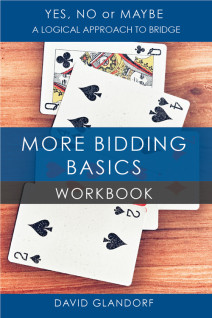All titles available from Master Point Press
Below is a complete list of all titles from Master Point Press
Yes, No or Maybe: Bidding Basics
Are you tired of learning/teaching bridge from a cookbook? Tired of memorizing how many points you need to bid this or that? Do you have trouble determining if you have a minimum, medium or maximum hand and what you are supposed to do if it fits in a particular category? Then Yes, No or Maybe is what you need. This is a series of three textbooks and companion workbooks for beginning bridge students. Bidding Basics introduces the student to bidding, including opening bids at the one-level with responses and rebids, overcalls and takeout doubles with advances and rebids, the use of cuebids by responder and advancer, and the practical application of the Law of Total Tricks. Once an opening bid has been made, responder and opener rely primarily on their answers to the basic questions to guide their bidding decisions. Their initial answers are usually ‘Maybe.’ But, as the bidding progresses, the answers are resolved into ‘Yes’ or ‘No’ and these answers govern the subsequent bidding. Of course, they must also have certain rules to follow regarding the number of cards shown with their bids as well as a few priorities for resolving bidding options. The same logical process is used for intervener and advancer after an overcall or takeout double. "I only wish that such a book had existed when I was starting out." Barbara Seagram Author of 25 Bridge Conventions You Should Know
Yes, No or Maybe: Bidding Basics Workbook
Are you tired of learning/teaching bridge from a cookbook? Tired of memorizing how many points you need to bid this or that? Do you have trouble determining if you have a minimum, medium or maximum hand and what you are supposed to do if it fits in a particular category? Then Yes, No or Maybe is what you need. This is a series of three textbooks and companion workbooks for beginning bridge students. This workbook accompanies the second textbook, Bidding Basics, which introduces the student to bidding, including opening bids at the one-level with responses and rebids, overcalls and takeout doubles with advances and rebids, the use of cuebids by responder and advancer, and the practical application of the Law of Total Tricks. Once an opening bid has been made, responder and opener rely primarily on their answers to the basic questions to guide their bidding decisions. Their initial answers are usually ‘Maybe.’ But, as the bidding progresses, the answers are resolved into ‘Yes’ or ‘No’ and these answers govern the subsequent bidding. Of course, they must also have certain rules to follow regarding the number of cards shown with their bids as well as a few priorities for resolving bidding options. The same logical process is used for intervener and advancer after an overcall or takeout double. "I only wish that such a book had existed when I was starting out." Barbara Seagram Author of 25 Bridge Conventions You Should Know
Yes, No or Maybe: Introduction and Card Play Basics
Are you tired of learning/teaching bridge from a cookbook? Tired of memorizing how many points you need to bid this or that? Do you have trouble determining if you have a minimum, medium or maximum hand and what you are supposed to do if it fits in a particular category? Then Yes, No or Maybe is what you need. This is a series of three textbooks and companion workbooks for beginning bridge students. The series uses a logical paradigm for making bidding decisions by formulating two basic questions: ‘Do we have a fit in a major suit?’ and ‘Do we want to be in a game contract?’ All partnership bidding after an opening bid or intervention is guided by the answers (Yes, No or Maybe) to these questions and some fundamental bidding guidelines. Introduction and Card Play Basics covers the mechanics of the game, a little bridge history, scoring, hand valuation and preferred contracts, along with the basics of declarer play and defense. No real bidding is included here but MiniBridge or a variant is used for sample and practice deals. The Yes, No, Maybe bidding concepts are introduced for the determination of preferred contracts. "I only wish that such a book had existed when I was starting out." Barbara Seagram Author of 25 Bridge Conventions You Should Know
Yes, No or Maybe: Introduction and Card Play Basics Workbook
Coming Soon Are you tired of learning/teaching bridge from a cookbook? Tired of memorizing how many points you need to bid this or that? Do you have trouble determining if you have a minimum, medium or maximum hand and what you are supposed to do if it fits in a particular category? Then Yes, No or Maybe is what you need. This is a series of three textbooks and companion workbooks for beginning bridge students. The series uses a logical paradigm for making bidding decisions by formulating two basic questions: 'Do we have a fit in a major suit' and 'Do we want to be in a game contract?' All partnership bidding after an opening bid or intervention is guided by the answers (Yes, No or Maybe) to these questions and some fundamental bidding guidelines. This workbook accompanies the first textbook, Introduction and Card Play Basics, which covers the mechanics of the game, a little bridge history, scoring, hand valuation and preferred contracts, along with the basics of declarer play and defense. No real bidding is included but MiniBridge or a variant is used for sample and practice deals. The Yes, No, Maybe bidding concepts are introduced for the determination of preferred contracts. "I only wish that such a book had existed when I was starting out." Barbara Seagram Author of 25 Bridge Conventions You Should Know
Yes, No or Maybe: More Bidding Basics
Are you tired of learning/teaching bridge from a cookbook? Tired of memorizing how many points you need to bid this or that? Do you have trouble determining if you have a minimum, medium or maximum hand and what you are supposed to do if it fits in a particular category? Then Yes, No or Maybe is what you need. This is a series of three textbooks and companion workbooks for beginning bridge students. The series uses a logical paradigm for making bidding decisions by formulating two basic questions: ‘Do we have a fit in a major suit?’ and ‘Do we want to be in a game contract?’ All partnership bidding after an opening bid or intervention is guided by the answers (Yes, No or Maybe) to these questions and some fundamental bidding guidelines. In More Bidding Basics the student learns about balancing, several conventions (Stayman, Jacoby transfers, negative doubles, fourth suit forcing, new minor forcing), strong opening bids, preemptive opening bids and overcalls, game tries, slam bidding (direct, Blackwood, Gerber, control bidding) and opening the bidding in third or fourth chair. The ‘Yes, No or Maybe’ philosophy is carried through into these somewhat advanced bidding scenarios. With regard to slam bidding, a new question is posed: “Do we want to be in a slam contract?” "I only wish that such a book had existed when I was starting out." Barbara Seagram Author of 25 Bridge Conventions You Should Know
Yes, No or Maybe: More Bidding Basics Workbook
Are you tired of learning/teaching bridge from a cookbook? Tired of memorizing how many points you need to bid this or that? Do you have trouble determining if you have a minimum, medium or maximum hand and what you are supposed to do if it fits in a particular category? Then Yes, No or Maybe is what you need. This is a series of three textbooks and companion workbooks for beginning bridge students. This workbook accompanies More Bidding Basics, in which the student learns about balancing, several conventions (Stayman, Jacoby transfers, negative doubles, fourth suit forcing, new minor forcing), strong opening bids, preemptive opening bids and overcalls, game tries, slam bidding (direct, Blackwood, Gerber, control bidding) and opening the bidding in third or fourth chair. The ‘Yes, No or Maybe’ philosophy is carried through into these somewhat advanced but what the author regards as still basic bidding scenarios. With regard to slam bidding, a new question is posed: “Do we want to be in a slam contract?” "I only wish that such a book had existed when I was starting out." Barbara Seagram Author of 25 Bridge Conventions You Should Know
You Have To See This
A brilliant sequel to There Must Be A Way, this book presents fifty-two more problems in post-mortem analysis. The two-step solution approach has been retained, and the hands are no less fun. Again, the reader is challenged to decide whether each hand can be made with best play and defence. For variety, in this book some hands are presented in single dummy format as well.
